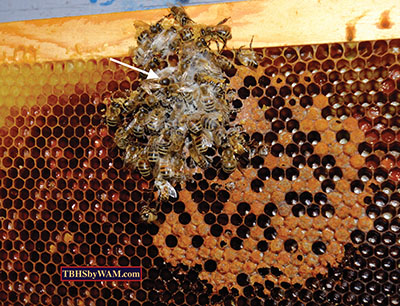
In the previous article, a thermal camera and a top-bar hive gave us a more intimate appreciation for the cold the bees endure in their hives. The top-bar colony shown last month was numerically strong with bees.
I had another colony in a far off apiary, not committed to another project, but not an ideal one to transfer to an observation hive. It was a weak colony occupying roughly four combs, but the bees did not cover any of the combs completely. The colony seemed low on honey too. Maybe it could survive on the stores it had. It was a close call. (The colony, starting out weak, did not need the standard recommended amount of honey.)
Proper fall beekeeping management meant I should have united this weak colony to another colony, creating one stronger colony with a better chance of winter survival. Except I learn best from situations that are not optimal. And besides, the weak colony had a good mark in its favor. The floor of its hive had no trash on it, not even a speck. Now scientifically, I do not know if a clean hive floor reliably indicates other good traits in bees, but to me, at least anecdotally, it was a hopeful sign.
A common observation under weak colonies is a layer of tiny bits of wax and other trash on the hive floor. This trash layer gives safe cover to the larvae of small hive beetles and greater wax moths. From the trash layer these destructive larvae can begin to invade the combs. Due to numerous mortality factors such as varroa mites, queen problems, etc. causing the colony to become weak, Figure 1 shows the most likely outcome I would find in the spring—a tiny colony that froze to death, unable to reach its stores.
Figure 2 shows the weak colony on December 28, 2017 during conditions cool enough to form a winter cluster, temperatures in the low 50°F (10°C) range. I drew an orange border around the edge of the cluster. The bees could cover approximately both sides of two top-bar combs top to bottom. However, the configuration shown with the bees covering the upper half of the combs would retain more heat. The bees starting the winter at the top of the combs are in danger of running out of stores. The cluster should begin the winter low on the combs, at the location of the former brood nest. Wide bands of capped honey should be above the cluster. Then as the winter progresses, the cluster slowly ascends into the stored honey above.
In the winter, I check the hives in all my apiaries with the thermal cameras. Winter is full of dreary cold nights, which are perfect for taking thermal images. The top-bar hives are fairly easy to determine general colony conditions. (Frame hives are more difficult because of the frame spacers, the end bars, which form another wall of wood that further distort the thermal image. I now have eight-frame hive equipment, enough for 20 hives, to study the use of thermal cameras with frame hives.)
From a top-bar hive in an apiary, a small amount of heat leaving the side of the hive high up near the top bars, in December, indicates a dead or nonviable colony by spring, in almost all cases. This weak colony resembled that situation, a worry for me. Another troubling detail in Figure 2 is the abundance of empty cells around the cluster. The arrows indicate the only capped honey visible in photograph. I know more honey is in the hive. Usually though, the bees have packed capped honey in the upper corners of the comb and down the edges.
As we recalled in the previous article, the cold blast came. During the first days of 2018, it seemed like the world….


